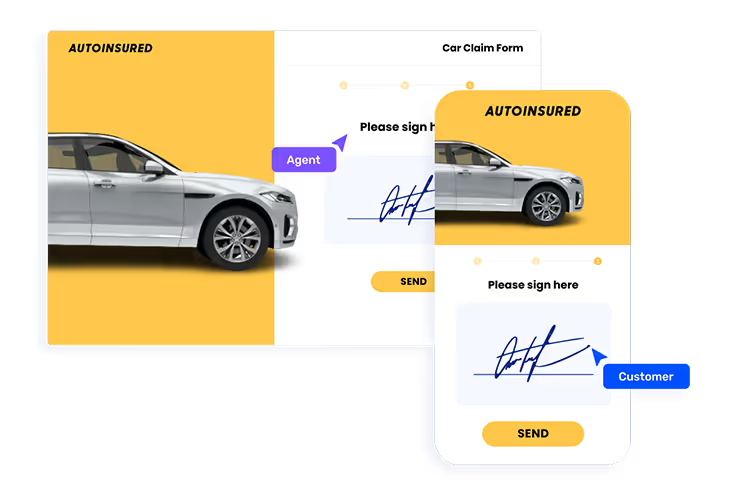What will insurance look like in 2025?
Digital trends shaping the future. Improving agility, delivering better service, and improving customer and employee experience became the number one priority.
We see an expedited adoption of remote signing and customer servicing technologies, tools for digital collaboration, and new innovative digital products.
As digital becomes the new normal, what lies ahead, and what should insurance leaders prepare for?
The evolution of technology
1. The rise of low-code/no-code development in enterprise IT
One of the most pronounced trends within the normalization of low-code/no-code development is enterprise IT. While in the SMB segment, no-code tools became the new norm, enterprises, for the most part, continued to rely on the traditional development projects powered by internal resources or external integrators.
However, this is now changing as vendors start to offer mature, enterprise-grade no-code tools focusing on security and compliance. So enterprises can now offload some security and compliance tasks to vendors while ensuring high-quality security and compliance standards.
Such tools owe their growing popularity to the fact that they solve some burning issues facing IT teams.
[.emph]The rise of low-code/no-code development is a direct result of the growing number of digital transformation projects that enterprises are implementing to meet customer demands, improve agility and deliver better service.[.emph]
It makes such initiatives easier to implement by reducing timeframes, costs, risks while increasing productivity and business results.
Accelerated time to market
The most crucial quality that makes no-code tools extremely attractive is accelerated time to market for new digital applications and products compared with traditional development projects. With no-code tools, Insurers can now deliver better apps at a quicker rate, improve customer experience, and enhance overall service quality.
Improving employee productivity
The rise of no-code development also allows Insurers to meet the evolving needs and demands of employees as well as satisfy their IT teams. In other words, organizations can now empower workers with self-service portals that let them access data from any device at any time while satisfying compliance requirements.
Simplify optimization and testing
In addition, developers can now use readymade no-code components that can be quickly assembled into a new app or product. These components allow them to build quick prototypes and MVPs for testing before rolling out the final version.
Boost security and compliance
The no-code development approach is also changing how enterprises manage their security and compliance policies as it allows organizations to automate most of the processes, streamline workflows, and ensure compliance and security at all times.
2. The rise of "headless tech"
It might sound somewhat gruesome, but "headless tech" is quite harmless and has been with us for a while. The most well-known example of headless technology can be found in website development. Traditional websites have a back-end and a front-end as well as a graphical user interface.
In a way, headless tech is a complementary trend that goes hand in hand with no-code tools for developing customer-facing front-ends.
[.emph]Insurers can now separate their front-end presentation layer from their back-end data functionality to create custom digital experiences.[.emph]
In Insurance, this is particularly important, as back-ends are mired with legacy technology problems that are, for the most part, make them incompatible with the modern front-end experiences customers expect.
By separating customer-facing front-ends and back-end processes while ensuring that the data flows freely between the two is another trend that we will see getting stronger in the near future. Our prediction is that we will see more insurance products and applications that adopt the same principle.

3. Hybrid cloud architecture is on the rise
According to Mordor Intelligence, the hybrid cloud market is expected to reach $128.01 billion by 2025, at a CAGR of 18.73% over the forecast period 2020 - 2025. Organizations increasingly adopt the hybrid cloud as they aim to leverage the advantages of both cloud and public clouds.
Hybrid cloud architectures improve both speed and flexibility by allowing organizations to go back and forth between their own tools and the cloud providers' toolkits.
[.figure]$128.01 bn[.figure]
[.emph]reach of the hybrid cloud market by 2025[.emph]
4. Augmenting legacy IT
Insurers are under no illusion that legacy applications are not going anywhere. However, a new generation of computing tools for digital natives is sweeping across the enterprise IT landscape.
These technologies will help insurers to solve existing problems with legacy architectures and improve customer experience, operational efficiency, and business agility at the same time.
The technology trends such as the rise of no-code tools and "headless tech" mean that financial service organizations can keep their legacy architectures intact while improving the digital experience for customers and employees at the same time.
The evolution of customer experience
5. Push for personalization and tailored digital products
Personalization capabilities are the new competitive edge. By offering a particular client, a particular product at a particular price point can significantly increase a policy sale probability.
Insurance companies that want to stay competitive need to have a personalization strategy. This way, they can create the best digital experience for their customers with tailored products and services based on user preferences and behavior patterns.
We've already seen how AI-driven personalized policy packages are changing insurance as we know it – now imagine what will happen once IoT is a part of the equation.
With more and more connected devices, IoT is generating huge amounts of data that can be used to create tailored products for customers in real time. This will make insurance policies much smarter, easier to understand and cheaper compared with their non-personalized counterparts.
Delivering tailored digital products is going to become a stronger focus of insurers in 2023 and beyond.
6. Digital channel as the primary channel
Insurance traditionally has been sold through physical channels, including agents or brokers, resellers, offices, and call centers. But now, the digital channel is gaining the edge.
Now, agents and brokers are increasingly moving to digital tools, while the self-service digital channel is also rising due to skyrocketing customer demand. A late-April 2020 survey of European insurance executives found that some 89% of respondents expect a significant acceleration in digitization, and most also anticipate a further shift in channel mix.
Increasingly, offline processes are transitioning into the digital realm. Even products that sometimes require offline execution, such as physical signatures and medical underwriting, are increasingly transitioning to digital with the help of technology such as legally binding eSignatures or face-recognition and telemedicine.
Compliance is also being increasingly automated, which allows insurers to more effectively stay on top of regulatory changes. Automated audit trail reports can help insurers detect and prevent compliance violations. At the same time, digital data can be automatically converted into PDF documents for archive, compliance and audit purposes.

7. Digitizing the customer journey
According to a survey by J.D. Power, nearly half of all insurance customers are likely to switch carriers within the next year if they discover that their insurer does not offer digital services such as automated claims submissions or 24/h service via mobile devices.
This means insurers need to offer modern solutions and improve self-service capabilities to stay competitive in the field.
Digital transformation does not stop at improving back-end operations. Insurer's must focus on digital front ends as well, including their mobile apps and websites.
In the insurance world, a truly digital customer experience not only means faster and more efficient claims processing or policy management. By taking advantage of innovative technologies such as cognitive computing, insurers can offer customers customized product recommendations based on their unique preferences.
As customer expectations increase exponentially, insurers must make sure they are able to meet their needs quickly and smoothly. In 2023, we expect digital technology and customer experience to play a major role across all insurance segments, as customers will continue demanding more personalized services (for example: round-the-clock assistance) that can be provided through mobile devices rather than traditional call centers.

8. The impact of AI-driven chatbots
AI is changing the way companies interact with customers for a number of reasons: firstly, chatbots are able to process information very quickly, which helps insurers provide customers with immediate answers.
Secondly, AI-driven bots can store knowledge and learn from interactions with their users over time. This means that once a bot has been trained it will be able to answer questions just as well as any human agent would. Finally, the technology is cost-effective and scalable, so many companies are already investing in chatbots that can handle basic customer inquiries.
In 2023 we expect to see more insurance providers offer AI driven bots on their websites and mobile apps. By providing customers with a quick and easy self-service experience through these automated interfaces, insurers will be able to lower costs while improving the customer experience.
The evolution of culture in the workplace
9. Welcome to the hybrid workspace
Work from home has been an exception, rather than the rule, for a very long time. However, it seems that even after the COVID-19 pandemic is behind us, the work from home culture will stay with us.
According to a recent survey by Bloomberquint, the number of workers who say they won't go back to the office full time has increased significantly, with over a quarter of those surveyed planning to continue working remotely at least half the time after the pandemic is over.
On the other hand, there is still a significant number of people who need to be in-person.
Organizations may not necessarily have to give up on either: they can set up flexible workspaces that make it possible for their employees and teams to work from home or go into an office as needed (after all, we are now only a few months away from a world where indoor spaces are mostly safe).
For insurers, this means that they need to support their employees to complete their tasks remotely while adding new tools and processes to boost collaboration and improve employee experience. Manual workflows have been outdated even before the pandemic, but (with some minor exceptions) in the post-pandemic world, there is no place for paper-based workflows that require employees' physical presence.

10. Inefficient, manual processes have to go
Inefficient paper-pushing has been the norm in the insurance industry for centuries. However, this is no longer feasible. Insurers cannot continue to treat inefficient paperwork as the necessary evil and need to find solutions to improve customer experience on that front.
As eSignatures and digital forms are being normalized, customers expect to complete nearly all (if not all) actions with their insurer remotely via digital tools - from account opening to policy renewals.
Paper-based workflows are out of date. Automated, digital-first processes are more efficient for everyone involved - customers get their claims processed faster, while employees have more time to focus on other aspects of servicing clients.
In 2023, the combination of artificial intelligence and digital transformation will allow organizations to aggressively cut down on their operating costs. In fact, many believe that these two trends will spur a new wave of disruption for the industry.
11. Employee empowerment through tech is a necessity
Managing teams of remote and on-site employees require a careful balance of efficiency and empowerment.
Employee-facing apps that encourage teamwork, efficient collaboration, and empower employees are a must in the new normal.
So inward-facing innovation is likely to become a strong focus in the insurance industry.

12. The shift in culture from conservatism to innovation
Insurance has traditionally been a very conservative industry. But it is now rapidly changing with the influx of new blood in the form of digital-first insurers, tech giants, and innovative startups.
There is a pronounced shift in the mindset among insurance leaders and experts, as the need to innovate is becoming apparent to everyone involved. The industry has shifted from a conservative into an increasingly innovation-focused, digital culture.
As we are closing in on the end of 2021, it is clear that we are headed towards more innovation, better customer and employee experience, increased agility, and innovative applications of existing technologies to age-old insurance problems such as risk-assessment claims processing and policy sales.
Maturing technologies gain wider acceptance
13. Wearable devices are on the rise
Wearable devices are also gaining traction, both in the insurance industry and beyond. As more people start having smart homes, cars or wearables such as fitness trackers, they will want their insurer to support them with solutions that add value through IoT integration.
For example: an insurer could offer a smart car alarm that automatically contacts the insurer's mobile app in case of an accident, providing assistance and automatic alerts about any claims.
Insurance companies can offer wearable-based rewards to their customers as a way of promoting healthy lifestyles while incentivizing policyholders towards longer periods of coverage/payment. These health programs are expected to experience significant growth over the next few years, especially with Millennials.
Insurance companies need to understand the claim patterns that affect their customers. Wearable devices have multiple applications in insurance, such as fitness tracking, anti-theft insurance policies, and usage-based car insurance.
Data and analytics from wearables, IoT devices, remote sensors etc., can help insurers better predict risks and improve processes. In 2023, we will see more emphasis on big data and advanced analytics so as to provide accurate forecasts for policyholders needs.

14. IoT increases the need for streaming analytics to innovate
Internet of Things supports insurance technology by providing accurate and real-time data. This improves the accuracy of risk assessment and gives insurance holders the ability to gauge their policy pricing accurately.
However, IoT implementation for risk assessment has many challenges. One of which is analytics. Data provided by IoT is real-time; unfortunately, real-time analytics leave much to be desired. We expect a lot of innovation in this space as the market demand for IoT has driven analytics grows.
15. Blockchain technology is here to stay, explore its possibilities
[.emph]Blockchain promises to reduce the time and costs associated with payments, claims processing, compliance checks etc., while increasing trust between insurers and their customers.[.emph]
Blockchain has been receiving significant attention from insurers as it can be used to provide transparency into transactions with effective record keeping across multiple participants while eliminating fraud or errors through immutability.
Blockchain is also expected to impact the insurance industry through decentralization, where users will take control over their data and decide how it's used.
Blockchain's influence in the insurance industry has so far been limited but will certainly grow over time. This year alone, we've seen several blockchain-based projects emerging from the insurance world including insurtechs using this decentralized ledger for everything from fraud reduction to managing personal data.
By 2023, we expect to see more companies invest in blockchain technology as it can be used for a variety of use cases such as securing data and reducing operational costs by eliminating intermediaries or providing currencies powered by smart contracts.
Fintechs that have already disrupted other industries such as lending to have a significant impact on insurance through the use of blockchain and cryptocurrencies.
For example: a startup could create its own currency that's used to pay for travel accidents or life events such as getting married. This currency would then be backed by an insurer, who provides coverage in case something goes wrong. While this is not necessarily a fintech business model, it shows how insurtech and fintech companies could work together to provide new services for customers.

16. The sharing economy is gaining traction in insurance industry
The so-called 'sharing economy' will play a big role in the future of insurance, according to research from Swiss Re, which states that it could be worth $220 billion by 2025 across 25 countries with nearly 70 percent of customers expecting their insurer to offer products from sharing economy companies.
Sharing economy has multiple ways it affects insurance industry. Firstly, it increases the need for peer-to-peer distribution channels. For example: Insurance holders could purchase their policy from a sharing economy company or an insurer that offers products from those companies.
On top of this, insurance holders want to be able to insure multiple assets on one platform as well as decide how they use and share data with other participants on the network.
Insurers and sharing economy companies will also need to figure out how they can work together as well as determine what new products or solutions they can offer customers through this collaboration.
Industry developments
17. Cybersecurity is still a big concern for insurers
In the digital age, cybersecurity remains one of insurance's most pressing concerns and will continue to be so in 2023. In fact, according to recent research from Accenture Strategy, nearly half of all businesses have been victims of cyberattacks in 2017 alone, with an average of $15 million in damages.
By 2023, we expect companies to make cybersecurity a priority and come out with new strategies (some more effective than others) for protecting themselves. In such an environment, insurers should take advantage by using the technology effectively and offering their services as part of cyber-risk protection packages. Cybersecurity is becoming a top priority for all industries, including insurance.
[.emph]According to an IBM Security survey report, data breaches now cost surveyed companies $4.24 million per incident on average – the highest cost in the 17-year history of the report.[.emph]
According to the Ponemon institute, due to the rise in remote work across industries and sectors, cyber attacks are up 148% from the previous year.
This trend is expected to continue into 2023 as companies will be forced to invest more resources for cybersecurity measures if they want to stay ahead of cybercriminals.
18. Claims management is going digital
Claims management process in the insurance industry will see significant improvements with greater digitization. Startups have already started disrupting this market by using chatbots for faster response and customer support while leveraging data analytics to enhance efficiency and reduce costs across the board. In the next few years, we expect this trend to continue and accelerate as most insurers move towards an automated claims management process.
19. The new role of brokers
With digitization transforming the insurance industry from top to bottom, a growing number of startups are also disrupting the brokerage space with innovative business models that connect customers directly with carriers while cutting out the brokers. This trend started a few years ago and is expected to continue in 2023, especially as fintechs focus more on insurance going forward.
In fact, according to recent research from McKinsey & Co., the global insurance broker market could be cut by up to 50% due to comprehensive digital disruption across all major segments of this market.

20. Increased focus on algorithmic risk assessment
Artificial Intelligence plays a significant role in the insurance industry. The AI-based tools provide solutions for insurance operations and claims settlement teams.
But Machine Learning has value beyond claims processing; it has the power to help insurers automate the entire process. As files are becoming increasingly digitized, they can be easily analyzed using AI algorithms, eliminating manual processing entirely.
This improves processing speed and accuracy, not only in policy administration but also in risk assessment. Machine learning and AI technologies are going to continue growing in popularity as risk assessment tools.
21. The rise of fintechs and insurtechs
The insurance industry has started to open up to new companies that aim at disrupting the incumbents with innovative business models, leveraging technology and data analytics capabilities for better efficiency and speed while providing customers with personalized services on demand. In 2016 alone, over $11 billion was invested in insurtech companies, and this number will continue to grow as more startups turn their focus towards insurance.
In 2023, we expect the fintechs that have already disrupted other industries such as lending to have a significant impact on the insurance industry by offering better customer experience while reducing costs for both customers and insurers alike.
22. Competition is becoming tougher
Competition is becoming tougher. Reinsurance News announces that Amazon is gearing up to enter the auto insurance market, and digital-first insurers such as Lemonade are bringing new digital experiences to the market. Incumbent insurers have a difficult time competing with these newcomers to their previously sheltered markets.
To compete in the increasingly digital marketplace, insurers must change their tactics to embrace digital transformation solutions.

23. Focus on maximizing conversions in policy sales
Just "going digital" is no longer enough. Maximizing conversion and improving sales funnels on digital channels becomes ever more important. Converting online visits into actual policy sales is a combination of art and science.
McKinsey's research shows how digitally smart insurers convert digital customers at six times the rate of their peers. And it seems that the key lies in personalization and continuous improvement of the customer experience.
24. Insurtech joint ventures
Partnerships between InsurTechs and incumbents are a growing trend, and for a good reason - it is often a win-win proposition.
Established insurers are harnessing their customer data and relationships and have the opportunities to create new income streams. While incumbents are tapping into their existing customer relationships and customer data, InsurTechs provide the technology, technical know-how, and support.

25. Proactive risk assessment and future-proofing
IoT technology keeps gaining momentum in the insurance industry, including risk assessment and underwriting. Most crucial of all, IoT theoretically can empower insurers to move from their traditional role in risk protection to risk prevention.
Going forward, digital transformation will likely become a key differentiator among financial services providers as more customers seek out the most convenient channels of service delivery which are generally based on online and mobile functionality.
Insurers that fail to adapt to the digital age will likely find themselves in a tough spot, especially if their competitors continue to grow and take market share.
26. Data and analytics in the spotlight
Data and analytic capabilities will be key differentiators for insurers going forward, as companies scramble to get their hands on even more granular information about customers' behaviours, needs and preferences.
For example, when underwriting a policy or responding to an insurance claim it is essential that you have access to all relevant data about the customer, their vehicle and claim history. This will help you avoid making bad decisions based on incomplete information.
Predictive analytics is another way data can be used to help insurers create better customer experiences. Insurers could build models that predict what products customers are most likely to need based on their behavior and demographics - for example, the average age of car buyers in a certain region, what a good selling price is for a given model of car, and so on. This in turn empowers personalization, which will help insurers deliver more relevant, timely and useful services to customers.
The bottom line: customer experience will be paramount
Successful digital transformation is all about delivering superior customer experiences. At the end of the day, it doesn't matter how much data you have or how advanced your analytics capabilities are if you can't deliver a great product and service to your customers.
The best way for insurers to compete in today's market is by creating a more streamlined, personalized and enjoyable customer experience.
.avif)



.avif)
.avif)


.avif)
